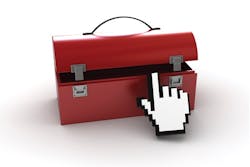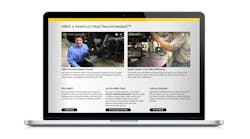Web-based computing is an increasingly prevalent option for managing a collision center. Whether closing files remotely, posting vehicle updates to websites, creating reports on multiple locations, or sending information about vehicles from the front-office computer to the ones the technicians and painters use on the shop floor, Web-based software management systems are helping shop operators solve business problems and streamline business tasks. We checked in with three collision centers to learn firsthand how the Web is helping them do business better. In short, they haven’t gone Web-based because of the bells and whistles. Rather, they’ve decided to work this way because it offered a solution to a problem or otherwise increased their productivity. Here are their stories.
COLLISION CARE AUTO BODY
** PHILADELPHIA, PA. **
Val Fichera, president of Collision Care, has been using Rome Technologies’ CompleteShop management software for a long time. In January, Fichera began using Rome’s CompleteASP service. Now his data is stored on Rome’s servers instead of his own, and he and his employees complete their management tasks via the Web.
Fichera owns five shops under the Collision Care Auto Body name in the Philadelphia area. Each shop has about 5,000 square feet and 12 employees. Together they repair about 600 cars a month for about $1 million a month in sales.
While CompleteASP has improved Fichera’s business in many ways, the most important is in accounting. Before, five company profiles had to be created in QuickBooks to keep track of the five locations. To compare shop data, the numbers had to be imported into Excel. Six checking accounts were maintained to track the money in and out of each location.
Not anymore. The company can now download each store’s data into QuickBooks from one location. Customers can drop their car at one location and pay for it at another. There’s no need for balance transfers between shops. What used to take 50 hours a week now takes one employee about 25 hours.
Saving Money Everywhere. “After nine months, we’re spending 30 percent less on technology,” Fichera says. “That includes what we’re paying Rome for the Web-based software. It doesn’t include having one less person in the corporate office and the $50,000 we’re saving from that salary.”
Fichera generates a report every morning that shows the results of each store: profitability, sales, cycle time, parts usage and more. Each manager gets a copy. “We’re doing so much better at managing the financial welfare of each store,” he says.
By tracking OEM usage by store and even by estimator, Fichera can zoom in on who’s ordering OEM parts and why. If an estimator is using OEM parts when an aftermarket part would do just as well, Fichera can detect that and deliver some spot training to the estimator. OEM usage is down 3 percent since working this way.
Error tracking has improved, too. “We’re able to audit every file before it’s closed. If our accounting person spots a $17 balance on a file that has been closed, she can look at the file with the person who closed it and walk them though the SOP that will prevent that from happening,” Fichera says.
Customer service has also improved. It’s now one person’s responsibility to contact the customers whose files closed each day and follow-up—before the insurance company does. “Before, there was a week-long window on that, but now it’s the next day,” Fichera says.
AA COLLISION
** OMAHA, NEB. **
Eric Dawson is candid about his struggles with management systems. “The last one I had was the biggest piece of crap I ever dealt with,” says the owner of AA Collision in Omaha, Neb. “I couldn’t make head or tail of what we’d actually done on a car, and had to go back to the estimating system to figure it out.” His new Web-based software from Summit Software Solutions has solved that problem.
Dawson’s shop has two locations, the original 10,000-square-foot shop in Omaha and a new 14,000-square-foot shop called Shadowlake in suburban Papilion, Neb. There are 10 employees at each shop. AA repairs about 55 cars a month and brings in about $1.8 million annually. Shadowlake repairs about 60 cars and earned $1.6 million in its first year (it will surpass that this year).
Before Shadowlake, Dawson didn’t much use the Web-based functions of CollisionRepairNet. But now he can access the data for one shop via the Web from the other shop, or he can use the Web to reach data for both from home. He can handle payroll and accounting tasks in the same way. And with vehicle status tracked in CollisionRepairNet, he can monitor workload, moving his painter shop-to-shop as needed.
The bookkeeper also uses the system, closing tickets, paying bills and tracking accounts receivable and payable. “She can be at one location, close tickets from the other and import them both to QuickBooks,” Dawson says.
Less Labor Intensive. Software updates happen automatically. “That’s a huge time savings. I no longer have to wait until after hours to do my updates,” Dawson says. Now he gets estimating and paint system updates via the Web, and they’re automatically loaded after hours. The Web-based system also automatically populates vehicle information and repair order to the paint computer; the painter no longer has to search for the order when he needs to mix paint.
Dawson says his use of the Web-based functions has evolved as he has gotten busier. The shop now sends instant messages to its aftermarket parts’ supplier when looking for parts. “We used to call, but now we just send them a quick IM about whether they have a used fender for a 2005 Honda Accord,” Dawson says. “By the time we have the information in the estimate, we usually have a quote and a response from them about the part.”
All this happens without an IT staff. Dawson outsources his IT support to a tech support company in Omaha called Computer Systems Inc. He has a secure connection to his network so that he can access it from home, and when he needs support specifically for CollisionRepairNet, he calls Summit’s user support line.
“[CollisionRepairNet] just makes your life easier when you have more than one location,” Dawson says. “It’s like being there without being there.”
EXPRESS PAINT & BODY
** LAKELAND, FLA. **
Does the prospect of putting client and car data on someone else’s server wrack your nerves a little too much? If so, take heart. Not all Web-based work solutions require letting loose of your client and accounting info. Express Paint & Body, for instance, stores just one slice of its data off-site.
Express Paint & Body has two shops in Lakeland, about 1.5 miles apart. The main location handles the drivable vehicles, repairing 100 to 120 of these a month, bringing in about $2 million a year in revenue. Cycle time is less than four days. The secondary location is dedicated to heavier work and bigger wrecks, and repairs about 30 cars a month. Annual revenue is about $1.7 million. That work requires more time: Average cycle time is 9.5 days, down from 14.5 days since implementing some Web-based functions of New Era Software’s AutoFocus management software. Employees use the Web-based software to track cars in process: sublet, detail, paint shop, body shop or completed. They also track each car by scheduled completion date.
With that information in the system, they can allocate resources more effectively if they’re falling behind schedule. They also use the Webview tool to let customers track their own cars. At the “Check Repair Status” button on the shop’s website, customers enter an identification code—their phone number—to get a status update, including information about what repairs have been done so far, pictures of the vehicle in progress and the name and picture of the assistant manager who’s keeping tabs on their vehicle.
The pictures are taken for the insurance company anyway, and a shop employee uploads those pictures to the system, designating which ones to publish to the site. The data on each vehicle’s status is also pulled automatically from AutoFocus and stored on NewEra’s servers. Express has the option to use the same tool to update insurance companies, rental car companies and adjusters when the staff is ready to take that step.
“Before the site went live [in December 2007], we’d call customers to update them and often play phone tag,” says Tammy Ryan, assistant manager. Now, vehicle status is updated about every two days.
Satisfied Customers. The expense is worth it, Ryan says. Customers like it, and the Web-based status check is a selling point for the shop. More important, Express is earning better customer satisfaction scores. Once in the high 80s, CSI scores now stay in the high 90s. Express does a lot of DRP work, and on the question about whether customers were informed about the status of their vehicles, scores have been great.
Express hasn’t used the site to update insurance or rental companies because both have adjusters on-site for now. “We want to make sure we’re smart about using the site,” Ryan says. After all, their goal is simply to repair cars right and keep customers happy. As it becomes apparent how Web-based business management tools help them do that, they just may expand its application to additional tasks and their other location.


